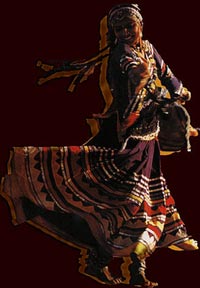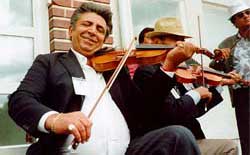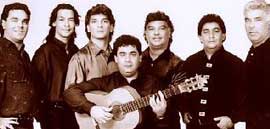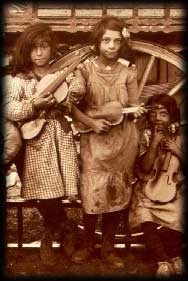Some links may be out dated and some audio no longer available due to licensing issues.
For more currrent reviews and articles, please check the home page

Michal Shapiro explores the music of the Roma
A groundswell of attention for Gypsy music has built slowly over the last few years. Ethnomusicologists have always been fascinated by Roma, but the public has only recently caught the fever. Although we have subliminal markers in our culture ("gypsy cab," "gypsy moth," "Gypsy Rose Lee" and the ubiquitous "gypped") the Gypsy as a real and breathing person is only now emerging.
 from the film Latcho Drom |
The reasons for the original migration are conjecture. Their persecutions, on the other hand, are a matter of record. For five hundred years they were slaves in Wallachia and Moldavia (which are now part of Romania) and were liberated only as recently as 1856. Even though their treatment in Eastern Europe was abominable, during that same time period in Western Europe, the flogging, branding, and in some cases hanging of Roma was encouraged. Possibly as many as a million were murdered in the holocaust. Today they live with continued harassment and marginalization in Eastern and Western Europe.
For hundreds of years, Roma have lived by traditions that keep them separate from the gadjé, and practiced rituals and obeyed laws that keep the loyal in, and the "unclean" out. This notion of clean and unclean manifests itself in complex washing rituals for laundering, housecleaning, and bathing. And contrary to the myth that Gypsy women are "loose," there are very strict rules regarding modesty and chastity. Today, traditional Roma continue to hold their own courts, where disputes of all kinds are settled, and the ultimate punishment within these courts is to be branded marimé, or unclean, and expulsed from the community.
Over the centuries the Roma have managed to survive on their wits and their skills; horse trading, metal working, fortune telling, begging, and of course music are some of the traditional livelihoods of the various groups. They have adapted their skills according to the times, and those groups that were once horse-traders are likely to be car salesmen now.
Today, hardly any Roma are nomadic, and in the United States there is a sophisticated network of territories, and a good percentage of middle-class Roma. The situation in Europe however, remains grim, with most Roma living well below the poverty line, particularly in Eastern Europe where the traumatized economies are breeding grounds for old prejudices. In Macedonia, which once housed one of the more harmonious Rom communities (in Skopje), the influx of refugees from the 1999 NATO extravaganza has resurrected anti-Gypsy sentiment.
It is of course unwise to try to make blanket statements about a people whose diaspora is so widespread, and there are exceptions to every rule; we are talking about people, not modules. Some gypsies do not even answer to the name "Rom." For example, in Spain they are "Caló", in Germany and France they are "Sinto," and in Israel and Egypt they are "Nawar." Today�s globalization will inevitably have an impact on the Roma of the world, whether it be an increasing national pride and political activism or greater assimilation into the gadjé population.
* Mihaela E. Giurca , Linguistics Department University of Pittsburgh, from "The Romani linguistic minority in Romania: language maintenance and shift." (There are now many resources to learn about the history of Roma, and many viewpoints abound. A balanced view is more likely through reading a combination of works, rather than just one.)
 Taraf de Haidouks photo: C.Funald |
Everywhere the Roma have played music, they have incorporated the local repertoire into their own. So if we listen to the "Gypsy music" of Hungary and compare it to the "Gypsy music" of Spain, one will seem to be Hungarian sounding, while the other will sound Spanish. But would they sound "more" Hungarian or "more" Spanish if played by non-Roma? This question leads us to:
3. There is a distinctive musical style which can always be associated with a Rom player. Here is a tantalizing statement, that invites us to listen to the breadth of Rom music and try to find common stylistic elements. For example, Roma have been credited with bringing the clarinet into the music of Greece, and there are many great players both Gypsy and non-Gypsy. It is possible, however, to tell the two apart. One has to listen for the exceptionally chromatic and fluid approach of the Rom player in the solos. A microtonal effect is achieved with the use of a very soft reed, and the phrasing is markedly free. There is a similar chromatic approach in the playing of Romanian Roma. This melismatic and free style could be a reference to the heritage of middle eastern or Indian music, with its microtones and lengthy improvisations, (improvisation plays an important role in Gypsy music) but there is no way to prove this. Other striking aspects of Rom music have to do with phrasing and vocal timbre. Roma tend to play behind the beat, creating a swinging "fat" feel, and to use chest voice rather than head tones. These elements certainly exist in other cultures, so again, there is no way to confidantly designate these as solely Gypsy attributes. One could just as easily describe these last two elements as "bluesey." And of course, we must mention the emotive aspect of "Gypsy music." Not all people respond to the abstract elements of music. They must have it "acted out" and to this end, the Roma have always obliged with plenty of drama and flash. It�s a living, after all.
After examining all three of these positions one may conclude that there is no conclusion. Perhaps there isn�t. It is always dangerous to try to formulate or categorize art. But the issues that these various viewpoints ask us to consider are fascinating, and serve to enrich our listening experience.
 Gipsy Kings |
The popularity of the Gipsy Kings gives them the distinction of being the most famous Roma in the world today. The band is made up of the sons and nephews of Jose Reyes, the great singer who collaborated for many years with Manitas de Plata. They have taken the impassioned vocals and driving guitars of flamenco, thrown in a healthy dash of rumba, and created a highly accessable and sellable product in the pop flamenco tradition. Ketama is another band that has pioneered the pop nuevo flamenco sound. Recently a band from Perpignan, Tekameli has been gaining popularity, and their CD on Sony Globetrotter is well worth checking out. The CD contains commercial recordings of music from the Evangelical church which has swept a multitude of Roma converts into its fold. In addition the guest shot by Khaled on one of the tracks is a chance to compare the Flamenco singing style with a north African style. For those who are particularly fascinated with the North African/Flamenco connection, Encuentros with Juan Pena Lebrijano on Globe Style Records is a chance to hear these interelationships at full tilt.
Although female children are encouraged to sing and dance, once they are of marrying age most Rom women are expected to be mothers and wives exclusively. A few have managed to carve out careers for themselves. Of these, the great diva of Gypsy music and the one who has gained the most widespread fame is the Macedonian Esma Redzepova. Her career started in the sixties, and she almost immediately became the darling of Europe through the efforts of her husband, Stevo Teodoievski, also from Macedonian, but of course, also because of her sweet, throaty voice and dramatic presentation. Esma continues to perform today and although her voice now has the rasp of age and use, she can still muster up plenty of power. Her delivery is hyperbolic, but at this point in time she is an institution. You can find her older recordings on Monitor records, which was recently bought out by Smithsonian. For more recent work, check out the fine compilation on Network Median, Gypsy Queens which also includes the singing of many other first-rate divas, including Dzansever in a rare appearence for a non-Turkish label.
The stereotypical musical image of the Gypsy is the Hungarian cafe violinist. The golden age of the Gypsy Orchestras of Budapest is long past, but it is important to note that never at any time did these ensembles play anything but Hungarian music. That is not to say that this music isn�t pleasant, good listening. The orchestras usually had a full compliment of violins and a cymbalom (another instrument that some have claimed the Roma disseminated), creating a beautiful lush sound. The repertoire drew from Hungarian folk and popular music, and was enjoyed by Rom and Gadjé alike. Some of these kinds of folk songs can be heard on Rom cymbalist Kálmán Balogh�s CD on Rounder.
The music that Hungarian Roma played while busking on the street, or in the country is quite different, entirely a capella, with the exception of hand clapping and milk-can percussion. A significant feature of the music in the rural areas is "oral-basing" in which the male voices sing highly rhythmic and syncopated bass lines. Hungaroton has re-issued a two CD set of field recordings, Gypsy Folksongs from Hungary which are the real deal.
Romanian Gypsies still play in tarafs (a word of Turkish origin meaning "bands") and the gypsies who make a living from music are known as lautari. (from the Romanian for "lute.") Right now though there are many excellent Gypsy tarafs in Romania, the most well known is the Taraf de Haidouks (Cramworld). The old state label Electrecorde also has an archive of great Gypsy music, and though they are at present a mail order business outside of Romania, one hopes that they will get international distribution soon. Meanwhile, even though a taraf can be either Rom or non-Rom, most CDs these days with the word "taraf" on it, are probably of Gypsy bands.
One of the most striking musical sounds one encounters in the areas of the former Yugoslavia is the brass band. The brass instruments were brought into the area during the Ottoman occupation, by the Janissaries, or military bands. After World War One, an entire repertoire sprang up to be played at celebrations. It is joyous and raucous stuff, though some bands have a smoother sound than others. The repertoire is mostly dance music, particularly the kolo, a circle dance of extraordary popularity. Bands nowadays can be both Rom or non-Rom, and often compete side by side in the annual brass band festival in Guca. Recordings of these bands exist, but very few are available outside the former Yugoslavia. However, Globestyle has a very fine recording of Jova Stojilkovic�s band (CDORBD 038) and the Macedonian brass band Kocani has several energetic recordings out (Cramworld), and the sound is quite similar. The brass band sound has also found its way into Romania (also considered a Balkan nation, although not a Slavic one) and Fanfare Ciocarlia on Piranha Records has become a real touring favorite in Europe.
For a more sinuous and hypnotically gorgeous Balkan music, check out Laver Bariu, Songs from the City of Roses which contains instrumental and vocal magic from Albania.
 Yuri Yunakov |
The highest concentration of Roma in Greece is in Epirus. However, finding Greek Rom music is a touchy business. The status of the Gypsies is so low that even though there are well known Rom players in Greece, (and the US) it is very rare to find one that will officially admit being one. (Roma are often referred to as "blacks" all over Europe, calling to mind many interesting parallels between the history of the Roma in Europe and the Africans in America.) Recordings are available, but don�t expect the liner notes to state that the player is a Gypsy. This prejudice runs extremely deep, so even if you ask the proprietor in a Greek music store, you may not get a straight answer. The clarinettist Yiorgos Mangas has several releases out, and seems to be one of the only Rom musicians willing to declare himself.
This stigma seems to lessen in Turkey, and you should have no trouble identifying recordings of Roma, particularly cifteteli, or belly dance music, should you have a savvy world music buyer in your local import store. If you are going to a large chain store, bands like Istanbul Oriental Ensemble or the Erkose brothers are Roma, and their CDs are widely available. The German import The Incredible Istanbul Gipsy Band, is another impressive entry from Feuer und Eis, Germany.
Recently there has been a lot of interest in "proto-gypsies" with several fascinating releases of music from Rajasthan in India and the Sind in Pakistan. This is the music of peoples who have many of the same traits as the Roma, but to which there is no conclusive connection. It is just an educated guess that the music they play is related to what the Roma in pre-diaspora times might have played. In that genre, Musafir, the ensemble that thrilled the audiences at the Gypsy Caravan concerts, has just released a CD on Sounds True Records. For a less calculated sound, try The Baluchi Ensemble of Karachi on Shanachie Records, or Sufi music of the Sindh on Wergo.
Other Sources:
Tangentially, Unblocked (CD3570) a compilation of Eastern European music on the Ellipsis Arts label has six tracks of Rom music, several not available anywhere outside of their homeland, including a track of possibly the greatest cymbalist ever, Toni Iordache, a man who never played a note he didn�t mean.
Opre Records, in Switzerland, is a label that is entirely dedicated to Rom music. Their stated goal is to "preserve the authenticity and diversity of Roma music, as well as to further its development." Opre�s two current releases, one of Russian Rom music (The Kolpakov Trio) and Tamburitza music from Vojvodina, the farmland that stretches between Hungary and the former Yugoslavia (Rromano Centar, Pera Petrovic) are available internationally.
Zingari, is a compilation of European Rom music on New Earth Records, made up of the recordings of Deben Battacharya, a pioneer of fieldwork since the 50's. While they may not have the fidelity we are used to these days, the music is as real as it gets.
Films:
Other resources:
Soundtrack, featuring Karandila Brass Orchestra
Well worth checking out, with a good sampling of styles both instrumental and vocal.
RootsWorld resources:
